-
 Bitcoin
Bitcoin $105,953.9980
3.06% -
 Ethereum
Ethereum $2,445.3292
6.68% -
 Tether USDt
Tether USDt $1.0006
-0.03% -
 XRP
XRP $2.1968
7.03% -
 BNB
BNB $643.2903
2.13% -
 Solana
Solana $144.2799
3.82% -
 USDC
USDC $1.0000
-0.03% -
 TRON
TRON $0.2739
0.49% -
 Dogecoin
Dogecoin $0.1642
4.47% -
 Cardano
Cardano $0.5834
5.49% -
 Hyperliquid
Hyperliquid $38.0741
2.80% -
 Sui
Sui $2.7741
7.56% -
 Chainlink
Chainlink $13.4107
11.26% -
 Bitcoin Cash
Bitcoin Cash $450.4828
-0.61% -
 UNUS SED LEO
UNUS SED LEO $9.1301
0.64% -
 Stellar
Stellar $0.2476
5.49% -
 Avalanche
Avalanche $18.0637
5.09% -
 Toncoin
Toncoin $2.9066
2.43% -
 Shiba Inu
Shiba Inu $0.0...01160
4.01% -
 Hedera
Hedera $0.1527
8.00% -
 Litecoin
Litecoin $84.6122
2.37% -
 Monero
Monero $317.6076
5.76% -
 Ethena USDe
Ethena USDe $1.0008
0.02% -
 Polkadot
Polkadot $3.4519
5.27% -
 Dai
Dai $1.0000
-0.03% -
 Bitget Token
Bitget Token $4.2835
5.62% -
 Uniswap
Uniswap $7.0443
9.78% -
 Pepe
Pepe $0.0...09964
7.41% -
 Pi
Pi $0.5391
4.64% -
 Aave
Aave $264.1743
11.26%
What does it mean when the price falls sharply and then rises the next day after the limit down?
A sharp cryptocurrency price drop often signals panic selling or negative news, but rebounds can occur if market sentiment shifts and buying pressure returns.
Jun 24, 2025 at 10:49 am
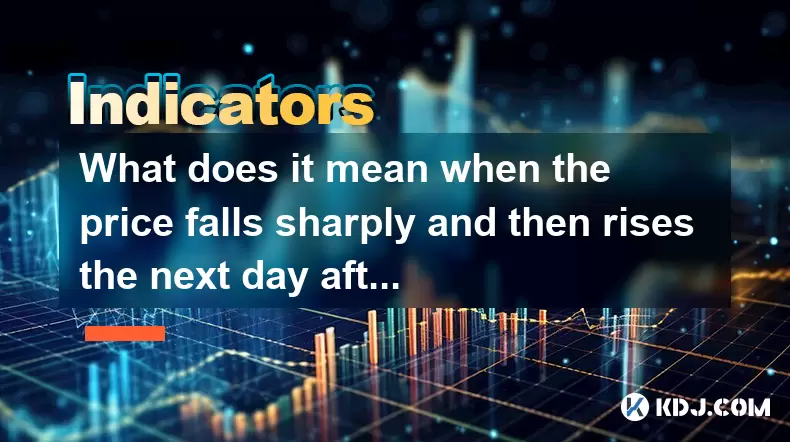
Understanding Sharp Price Drops in Cryptocurrency
When a cryptocurrency experiences a sharp price drop, it typically indicates a sudden and significant decline in its market value. This phenomenon can be attributed to various factors, including negative news, regulatory changes, or large sell-offs by institutional investors. In the context of a limit down event, where trading is halted due to excessive volatility, a sharp fall may occur as traders panic and rush to sell their holdings.
Limit down scenarios are particularly relevant in traditional markets but less common in cryptocurrency exchanges. However, some platforms may implement similar mechanisms during extreme market conditions. The immediate aftermath of such an event often sees heightened uncertainty among traders, which can lead to further downward pressure on prices before any recovery begins.
The Role of Market Sentiment in Post-Drop Recovery
Following a sharp decline, especially after a limit down situation, market sentiment plays a critical role in determining whether the price will recover quickly or continue falling. If the initial drop was caused by temporary factors—such as a short-term rumor or technical glitch—traders might see the lower price as an opportunity to buy at a discount. This influx of buyers can cause the price to rebound significantly the next day.
Conversely, if the drop stems from long-term concerns like regulatory crackdowns or technological vulnerabilities, the recovery might take longer. Positive developments that counteract the original cause of the drop can trigger a rebound, such as official statements from project teams, favorable legal rulings, or broader market stabilization.
Technical Analysis of Sudden Downturns and Reversals
From a technical perspective, a sharp drop followed by a strong recovery often creates what traders call a "reversal candlestick pattern." These patterns suggest that selling pressure has exhausted itself and buying momentum is returning. Traders who monitor such signals closely may enter long positions once they observe signs of stabilization, contributing to the subsequent price increase.
Additionally, volume spikes during both the drop and the recovery can provide insight into the strength of the move. High volume during the fall indicates aggressive selling, while high volume during the rebound suggests strong buying interest. Analyzing these patterns helps traders assess whether the recovery is sustainable or just a temporary bounce.
Psychological Factors Influencing Trader Behavior
The emotional response of traders significantly impacts post-limit down dynamics. After witnessing a steep decline, many investors experience fear and uncertainty, prompting them to liquidate their positions prematurely. This behavioral bias known as "panic selling" exacerbates the initial drop.
However, once the market stabilizes, some traders realize that the worst-case scenario did not materialize, leading them to re-enter the market. This shift in psychology from fear to optimism can drive rapid price increases, especially when the underlying fundamentals of the asset remain intact or show signs of improvement.
Historical Examples of Sharp Drops Followed by Rebounds
Several notable instances in the crypto space demonstrate how assets have reacted after experiencing severe drops followed by rebounds. For example, Bitcoin faced a dramatic crash in March 2020 due to global economic turmoil triggered by the pandemic. Despite this, it recovered within weeks and eventually reached new all-time highs later that year.
Similarly, Ethereum saw sharp declines during flash crashes or exchange-related incidents, only to rebound strongly afterward. These examples illustrate that while sudden drops can be alarming, they do not always signal permanent losses. Instead, they often present opportunities for informed traders who understand market cycles and risk management strategies.
Frequently Asked Questions
Q: What should I do if my cryptocurrency experiences a sharp drop and then recovers?
A: Assess the reason behind the drop first. If it was due to temporary issues and the fundamentals remain strong, holding or even adding to your position could be viable. Always consider your risk tolerance and investment strategy before making decisions.
Q: Can limit down rules apply to cryptocurrencies?
A: While most crypto exchanges do not enforce formal limit down rules like traditional stock markets, some may temporarily halt trading during extreme volatility. These halts aim to prevent panic selling and give traders time to reassess.
Q: How can I identify a potential rebound after a sharp drop?
A: Look for increased buying volume, positive news related to the project, and technical indicators like bullish candlestick patterns. Monitoring social media sentiment and expert analysis can also help gauge market mood.
Q: Is it safe to buy after a major price drop?
A: It depends on the cause of the drop and your understanding of the asset. Buying the dip can be profitable if done with proper research and risk management. Never invest based solely on emotion or FOMO (fear of missing out).
Disclaimer:info@kdj.com
The information provided is not trading advice. kdj.com does not assume any responsibility for any investments made based on the information provided in this article. Cryptocurrencies are highly volatile and it is highly recommended that you invest with caution after thorough research!
If you believe that the content used on this website infringes your copyright, please contact us immediately (info@kdj.com) and we will delete it promptly.
- BlockDAG: The Cryptocurrency ROI Revolution
- 2025-06-25 06:45:12
- Layer 1 Crypto Token Presales: What's Hot in the NYC Crypto Scene?
- 2025-06-25 06:30:12
- Ethereum, Investors, and Memecoins: A Wild Ride on the Crypto Coaster
- 2025-06-25 06:30:12
- SEI Price Explodes: Is This Just the Beginning?
- 2025-06-25 07:05:13
- Meme Coins Mania: Arctic Pablo and the Hunt for Presale Gains
- 2025-06-25 06:50:13
- Mark Cuban, Meme Coins, and Scams: A Cautionary Tale
- 2025-06-25 07:05:13
Related knowledge
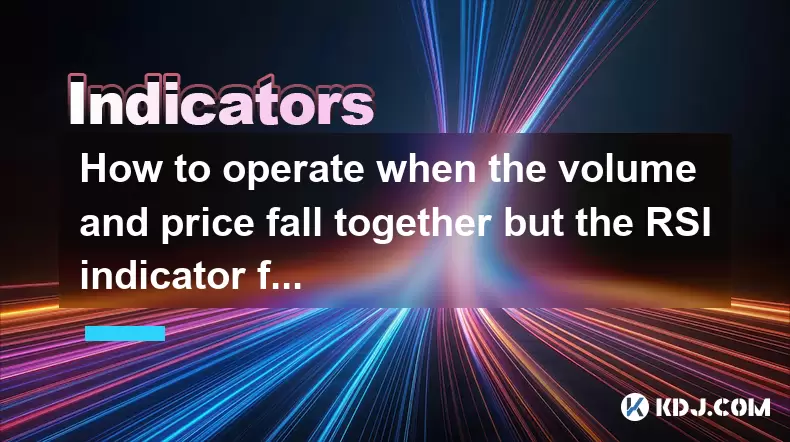
How to operate when the volume and price fall together but the RSI indicator forms a bottom divergence?
Jun 25,2025 at 04:29am
Understanding the Concept of RSI Bottom DivergenceWhen analyzing cryptocurrency price charts, traders often rely on technical indicators to spot potential reversals. One such signal is a bottom divergence in the Relative Strength Index (RSI). This occurs when the price makes a new low, but the RSI does not confirm that low and instead forms a higher low...
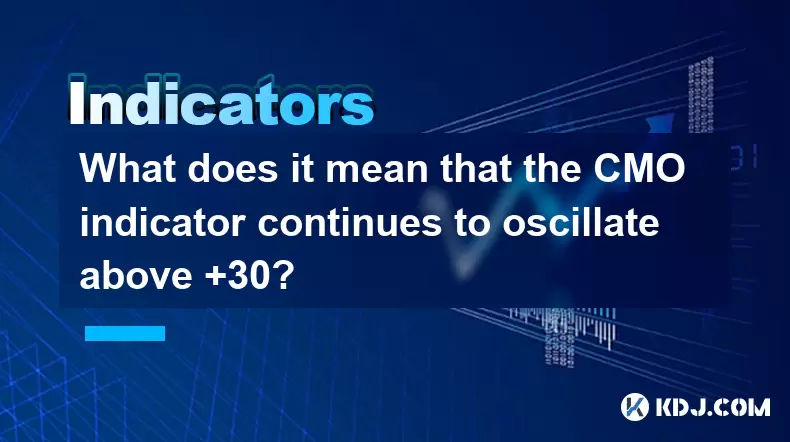
What does it mean that the CMO indicator continues to oscillate above +30?
Jun 25,2025 at 03:29am
Understanding the CMO IndicatorThe Chande Momentum Oscillator (CMO) is a technical analysis tool developed by Tushar Chande to measure momentum in financial markets. In cryptocurrency trading, the CMO helps traders identify overbought or oversold conditions and potential trend reversals. The oscillator ranges from -100 to +100, with values above zero in...

What does it mean that the ATR indicator suddenly doubles after hitting a new low this year?
Jun 24,2025 at 11:57pm
Understanding the ATR IndicatorThe Average True Range (ATR) is a technical analysis indicator used to measure market volatility. Developed by J. Welles Wilder, ATR calculates the average price range between a security’s high and low over a specific period—typically 14 periods. It does not indicate the direction of price movement but rather how volatile ...
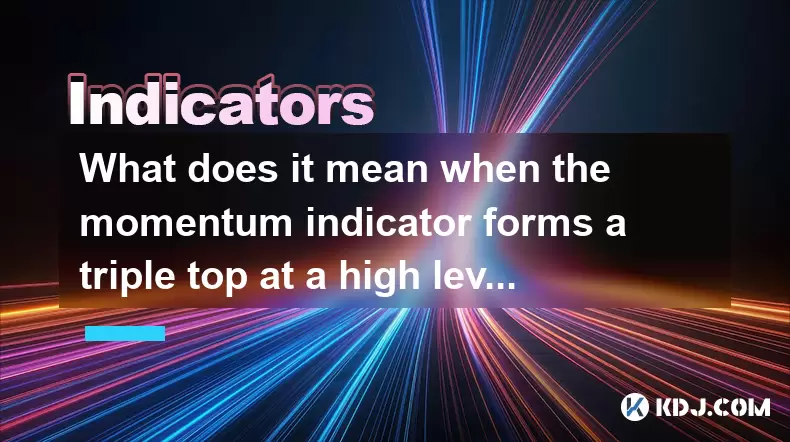
What does it mean when the momentum indicator forms a triple top at a high level?
Jun 25,2025 at 03:15am
Understanding the Momentum Indicator in Cryptocurrency TradingThe momentum indicator is a widely used technical analysis tool that measures the rate of change in price movements over a specified period. In cryptocurrency trading, where volatility is high and trends can reverse rapidly, this indicator helps traders identify potential trend reversals or c...
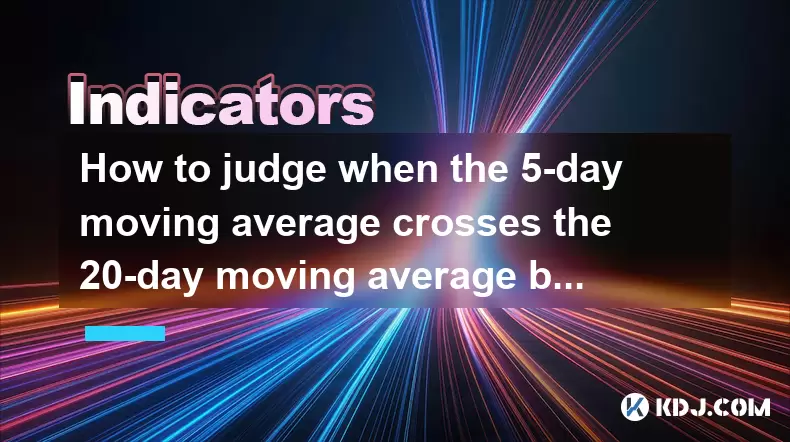
How to judge when the 5-day moving average crosses the 20-day moving average but the RSI shows a top divergence?
Jun 25,2025 at 06:28am
Understanding the Basics of Moving Averages and RSIIn technical analysis, moving averages are essential tools used to identify trends in price movements. The 5-day moving average (MA) is a short-term indicator that reflects recent price action, while the 20-day MA offers a broader perspective over a longer period. When these two lines intersect, it's kn...

What does the divergence between the volatility indicator and the price indicate?
Jun 25,2025 at 06:07am
Understanding the Volatility IndicatorThe volatility indicator is a technical analysis tool used to measure the rate and magnitude of price movements in financial markets, including cryptocurrencies. It helps traders assess whether a market is experiencing high or low volatility, which can influence trading decisions. Common types of volatility indicato...

How to operate when the volume and price fall together but the RSI indicator forms a bottom divergence?
Jun 25,2025 at 04:29am
Understanding the Concept of RSI Bottom DivergenceWhen analyzing cryptocurrency price charts, traders often rely on technical indicators to spot potential reversals. One such signal is a bottom divergence in the Relative Strength Index (RSI). This occurs when the price makes a new low, but the RSI does not confirm that low and instead forms a higher low...

What does it mean that the CMO indicator continues to oscillate above +30?
Jun 25,2025 at 03:29am
Understanding the CMO IndicatorThe Chande Momentum Oscillator (CMO) is a technical analysis tool developed by Tushar Chande to measure momentum in financial markets. In cryptocurrency trading, the CMO helps traders identify overbought or oversold conditions and potential trend reversals. The oscillator ranges from -100 to +100, with values above zero in...

What does it mean that the ATR indicator suddenly doubles after hitting a new low this year?
Jun 24,2025 at 11:57pm
Understanding the ATR IndicatorThe Average True Range (ATR) is a technical analysis indicator used to measure market volatility. Developed by J. Welles Wilder, ATR calculates the average price range between a security’s high and low over a specific period—typically 14 periods. It does not indicate the direction of price movement but rather how volatile ...

What does it mean when the momentum indicator forms a triple top at a high level?
Jun 25,2025 at 03:15am
Understanding the Momentum Indicator in Cryptocurrency TradingThe momentum indicator is a widely used technical analysis tool that measures the rate of change in price movements over a specified period. In cryptocurrency trading, where volatility is high and trends can reverse rapidly, this indicator helps traders identify potential trend reversals or c...

How to judge when the 5-day moving average crosses the 20-day moving average but the RSI shows a top divergence?
Jun 25,2025 at 06:28am
Understanding the Basics of Moving Averages and RSIIn technical analysis, moving averages are essential tools used to identify trends in price movements. The 5-day moving average (MA) is a short-term indicator that reflects recent price action, while the 20-day MA offers a broader perspective over a longer period. When these two lines intersect, it's kn...

What does the divergence between the volatility indicator and the price indicate?
Jun 25,2025 at 06:07am
Understanding the Volatility IndicatorThe volatility indicator is a technical analysis tool used to measure the rate and magnitude of price movements in financial markets, including cryptocurrencies. It helps traders assess whether a market is experiencing high or low volatility, which can influence trading decisions. Common types of volatility indicato...
See all articles
























































































